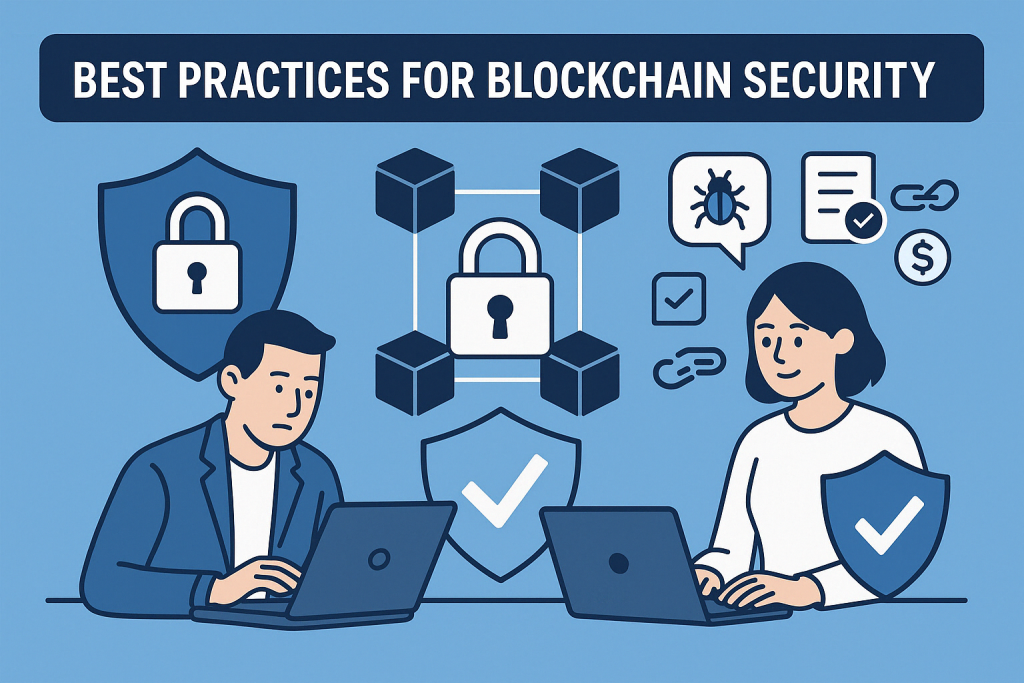📌 Introduction: When Millions Vanish Overnight
In February 2025, a newly launched DeFi platform lost over $18 million in a flash loan exploit that went undetected for hours. The team had no code audit, no multisig wallets, and worst of all — no contingency plan.
Blockchain security is no longer optional. As Web3 matures, security breaches have become more sophisticated, costlier, and more public.

This 2025 handbook offers a comprehensive guide to the best practices for blockchain security — from smart contract defenses to user-end protections. Whether you’re a developer, investor, or founder, this article will arm you with the practical insights to navigate blockchain safely.
🔍 What Is Blockchain Security?
Blockchain security refers to the systematic application of cybersecurity principles to distributed ledger technologies (DLT), including:
- ✅ Network-level protections (e.g., Sybil resistance, consensus validation)
- ✅ Smart contract auditing and bug detection
- ✅ Wallet protection mechanisms
- ✅ Governance and key management systems
- ✅ Regulatory compliance in code
It covers both on-chain (protocol layer, smart contracts) and off-chain (wallets, oracles, interfaces) vulnerabilities.
📈 Why Blockchain Security Matters More in 2025
With over $200 billion now locked in DeFi protocols and hundreds of millions participating in NFT, DAO, and crypto ecosystems, the attack surface has exploded.
New risks in 2025 include:
- AI-generated malware targeting wallets and interfaces
- Quantum-aware cryptographic exploits
- AI-fuzzing to discover smart contract vulnerabilities
- Zero-day exploits in popular multisig wallets
As complexity increases, so does the need for proactive and layered security.
✅ Best Practices for Blockchain Security (2025 Edition)
Here’s a structured, prioritized security checklist for blockchain projects and users:
1. 🔍 Smart Contract Auditing
- Use multiple third-party auditors (e.g., CertiK, OpenZeppelin)
- Integrate AI-powered audit tools (e.g., MythX, Code4rena)
- Conduct fuzz testing and formal verification
2. 🧰 Multi-Sig and Role-Based Access Control
- Use multisig wallets (Gnosis Safe) for treasury and upgrades
- Limit admin keys, implement time-locks for critical operations
3. 🔒 Key Management & Hardware Security
- Store private keys using hardware wallets (Ledger, Trezor)
- Use MPC (multi-party computation) for institutional access
- Avoid browser-based extensions as primary wallets
4. 🌐 Frontend & API Protections
- Rate-limit API access
- Validate all user inputs client- and server-side
- Secure your DNS, avoid front-end dependency injection
5. 🧠 Governance Safeguards
- Educate DAO participants on proposal implications
- Require quorum and timelocks for major changes
- Monitor for vote-buying or flash-loan manipulation
6. 👨💻 Bug Bounties and Continuous Monitoring
- Launch bug bounty programs (via Immunefi, HackenProof)
- Set up automated alerts (e.g., Forta for contract behavior anomalies)
- Monitor GitHub commits, dependency updates, oracle feeds
⚖️ Pros and Cons of Blockchain Security Best Practices
| ✅ Benefits | ⚠️ Challenges |
|---|---|
| Prevent loss of funds | May increase operational complexity |
| Build user trust & reputation | May slow down deployment |
| Attract institutional partners | Increased cost of audits & tools |
| Stay compliant with regulations | Requires ongoing maintenance |
Remember: security is not a one-time checklist. It’s an ongoing culture and process.
🌐 Authoritative Sources to Learn More
❓ FAQ: Blockchain Security in 2025
1. What is the most common cause of DeFi hacks?
Smart contract vulnerabilities remain the #1 reason, often due to unaudited or rushed code.
2. Are audited contracts 100% secure?
No. While audits reduce risk, they are not a guarantee. Continuous monitoring is also essential.
3. Can AI help secure smart contracts?
Yes. AI-powered tools can help detect anomalies, simulate attacks, and optimize security patches.
4. What are multisig wallets and why are they important?
They require multiple approvals for transactions, reducing the risk of single-point compromise.
5. How can users protect themselves when using dApps?
Use trusted wallets, enable spending limits, don’t click unknown links, and verify contract addresses.
6. Is quantum computing a real threat to blockchain in 2025?
It’s emerging. Some protocols are already exploring post-quantum cryptographic upgrades.
🧭 Final Thoughts
As the blockchain industry matures, security is the bedrock of sustainability. A single flaw can destroy years of progress and millions in value.
Whether you’re building the next DeFi unicorn or trading NFTs from your phone, applying these best practices is no longer a recommendation — it’s a necessity.
🔐 Build secure. Invest smart. Stay vigilant.
✅ Action Steps for Readers
- 🧠 Bookmark this guide and share it with your dev team or DAO community.
- 🛡️ Check out Immunefi for bounties and case studies.

